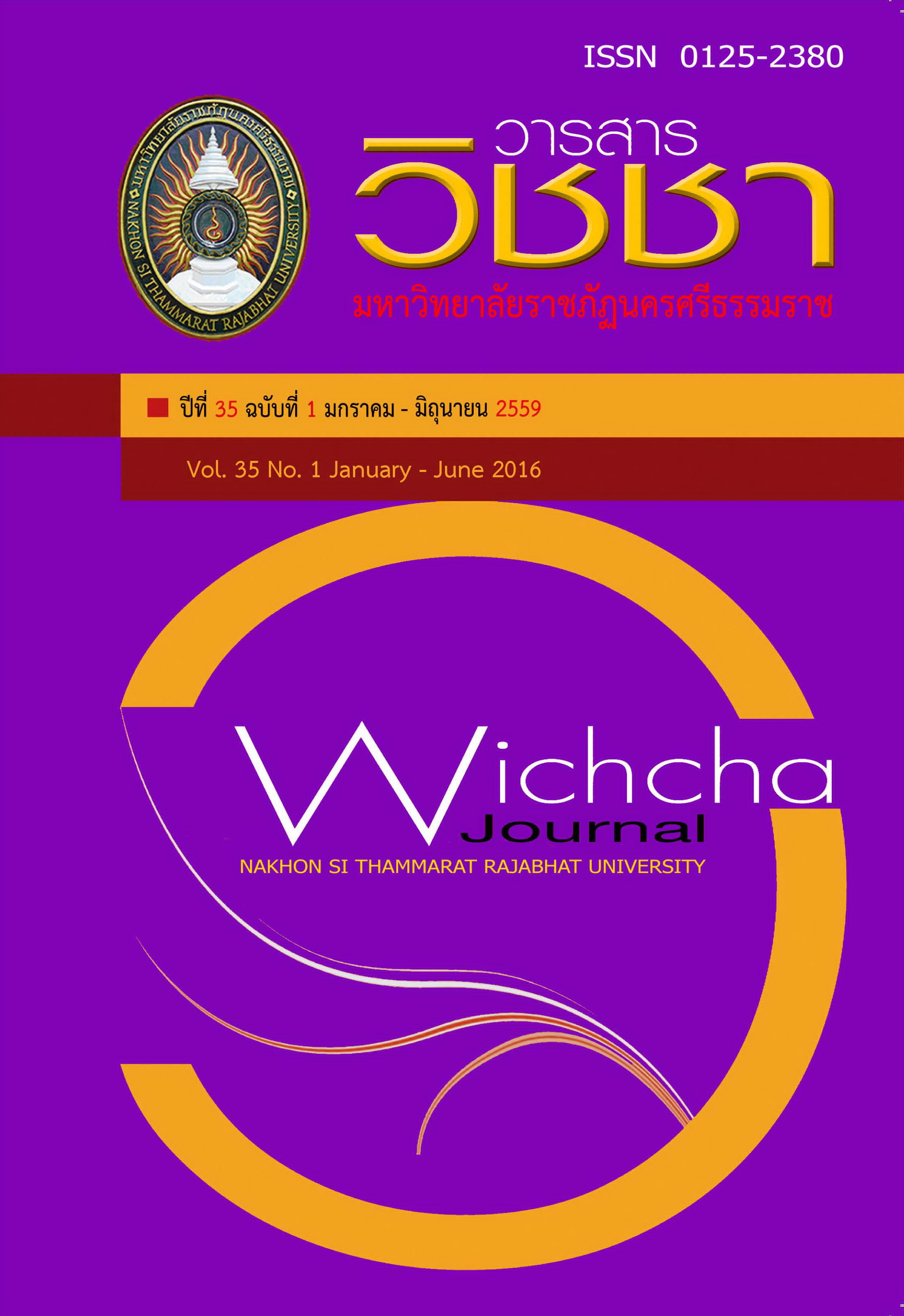การพัฒนาวิธีวิเคราะห์โลหะหนักในน้ำดื่มของโรงเรียนในเขตจังหวัดนครศรีธรรมราช ด้วยอุปกรณ์ของไหลจุลภาคบนกระดาษ Method Development for Determination of Heavy Metals in Drinking Water of Schools in Nakhon Si Thammarat by Paper-Based Microfluidic Devices
Main Article Content
Abstract
การวิเคราะห์นิกเกิล(II) อะลูมิเนียม(III) และเหล็ก(II) ในน้ำดื่มด้วยอุปกรณ์ของไหลจุลภาคบนกระดาษ อุปกรณ์ที่สร้างโดยการสกรีนด้วยเทียนและออกแบบให้สามารถวิเคราะห์ได้อย่างรวดเร็วและมีความจำเพาะเจาะจงต่อการวิเคราะห์โลหะทั้งสามชนิด บริเวณตรวจวัดจะเกิดเป็นสารเชิงซ้อนระหว่างนิกเกิล(II) กับ Dimethylglyoxime (DMG) เกิดเป็นสีชมพู ส่วนอะลูมิเนียม(III) จะเกิดเป็นสาร
เชิงซ้อนกับสารสกัดกะหล่ำปลีสีม่วงเกิดเป็นสีน้ำเงิน และเหล็ก(II) จะเกิดเป็นสารเชิงซ้อนกับ 1,10-phenanthroline ให้สีส้มแดง หาความเข้มสีเฉลี่ยด้วยโปรแกรม Image J ในโหมดสีเทาภายใต้สภาวะการทดลองที่เหมาะสมกราฟมาตรฐานของนิกเกิล(II) อะลูมิเนียม(III) และเหล็ก(II) อยู่ในช่วงความเข้มข้น 1–15 มิลลิกรัมต่อลิตร(R2=0.9985) 0.05–15 มิลลิกรัมต่อลิตร(R2=0.9952) และ0.005–1.0 มิลลิกรัมต่อลิตร (R2=0.9975) ตามลำดับขีดจำกัดของการตรวจวัด (LOD) ของนิกเกิล(II)อะลูมิเนียม(III)และเหล็ก(II) เท่ากับ 1, 0.05 และ 0.005 มิลลิกรัมต่อลิตร และมีค่าเบี่ยงเบน-มาตรฐานสัมพัทธ์ (%RSD) เท่ากับ 1.0, 1.1 and0.6% (n = 10) ตามลำดับสามารถนำมาประยุกต์ใช้สำหรับการวิเคราะห์นิกเกิล(II) อะลูมิเนียม(III) และเหล็ก(II) ในน้ำดื่มของโรงเรียนในจังหวัดนครศรีธรรมราชได้ซึ่งจากการตรวจวัดปริมาณโลหะนิกเกิล(II) อะลูมิเนียม(III) และเหล็ก(II)พบว่าตรวจไม่พบการปนเปื้อนของโลหะทั้งสามชนิดในตัวอย่างน้ำดื่มของโรงเรียนทั้ง 21 แห่ง ให้ค่าเปอร์เซ็นต์การคืนกลับ (%Recovery) อยู่ในช่วง 84–120% เมื่อเปรียบเทียบวิธีที่พัฒนาขึ้นกับวิธีมาตรฐาน(Inductively coupled plasma optical emission spectrometry, ICP-OES) ทั้งสองวิธีให้ผลไม่แตกต่างกันอย่างมีนัยสำคัญที่ระดับความเชื่อมั่น 95% (t-test) ดังนั้นวิธีนี้เป็นอีกทางเลือกหนึ่งสำหรับการวิเคราะห์นิกเกิล(II) อะลูมิเนียม(III)และเหล็ก(II) ที่สามารถทำได้รวดเร็วย่อยสลายได้ดีเป็นมิตรต่อสิ่งแวดล้อม รวมทั้งเป็นการลดค่าใช้จ่ายในการวิเคราะห์ตัวอย่าง
A colorimetric method was developed for determination of iron (Fe(II)), nickel (Ni(II)) and aluminum (Al(III)) ions. The analytical device constructed by solid wax printing on filter paper. The Fe(II) was detected by reaction of Fe(II) with 1,10- phenanthroline in the red/orange ferro in complex [Fe(phen)3]2+ formed. In term of the Ni(II) determination, dimethylglyoxime (DMG) was used to produce bright pink Ni- DMG. For the Al(III) detection, analyzed by using cyanid in extracted from red cabbage. The colors in detection zone were immediately changed after dropping the three ions, and the colors changing depended on their concentrations. The color intensities were analyzed by using Image J software in gray mode. Under the optimum conditions, the linear range between the color intensity and the concentration of Ni(II), Al(III) and Fe(II) were found to be 1–15 mg L-1(R2=0.9985) 0.05–15 mg L-1(R2=0.9952) and0.005–1.0 mg L-1(R2=0.9975), respectively. The limits of detection (LOD) for Ni(II), Al(III) and Fe(II) were found at 1.0, 0.05 and 0.005 mg L-1, while the relative standard deviation (%RSD) were 1.0, 1.1 and 0.6% (n=10), respectively. The developed method can be successfully applied to the
determination of metal ions for drinking water samples of schools in Nakhon Si Thammarat. The recoveries were in the range of 84–120%. The procedure provides rapid, sensitive and selective for metal ions detection in water samples, minimal reagent usage, low cost, and is especially suitable for on-site environmental monitoring.
Article Details
เนื้อหาและข้อมูลในบทความที่ลงตีพิมพ์ในวารสารวิชชา มหาวิทยาลัยราชภัฏนครศรีธรรมราช ถือเป็นข้อคิดเห็นและความรับผิดชอบของผู้เขียนบทความโดยตรง ซึ่งกองบรรณาธิการวารสารไม่จำเป็นต้องเห็นด้วยหรือร่วมรับผิดชอบใด ๆ
บทความ ข้อมูล เนื้อหา รูปภาพ ฯลฯ ที่ได้รับการตีพิมพ์ในวารสารวิชชา มหาวิทยาลัยราชภัฏนครศรีธรรมราช ถือเป็นลิขสิทธ์ของวารสารวิชชา มหาวิทยาลัยราชภัฏนครศรีธรรมราช หากบุคคลหรือหน่วยงานใดต้องการนำข้อมูลทั้งหมดหรือส่วนหนึ่งส่วนใดไปเผยแพร่ต่อหรือเพื่อการกระทำการใด ๆ จะต้องได้รับอนุญาตเป็นลายลักษณ์อักษรจากวารสารวิชชา มหาวิทยาลัยราชภัฏนครศรีธรรมราชก่อนเท่านั้น
The content and information in the article published in Wichcha journal Nakhon Si Thammarat Rajabhat University, It is the opinion and responsibility of the author of the article. The editorial journals do not need to agree. Or share any responsibility.


